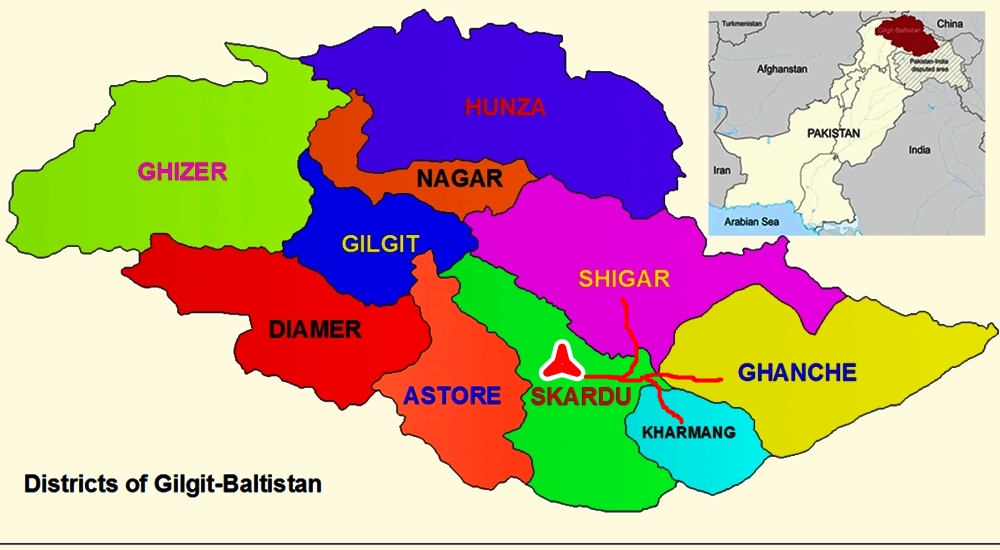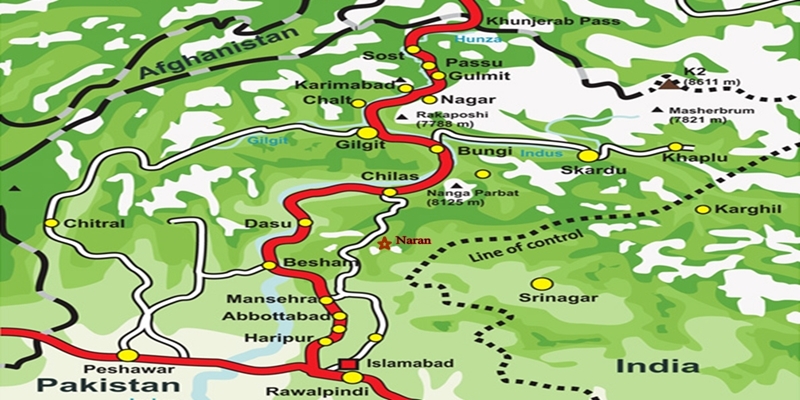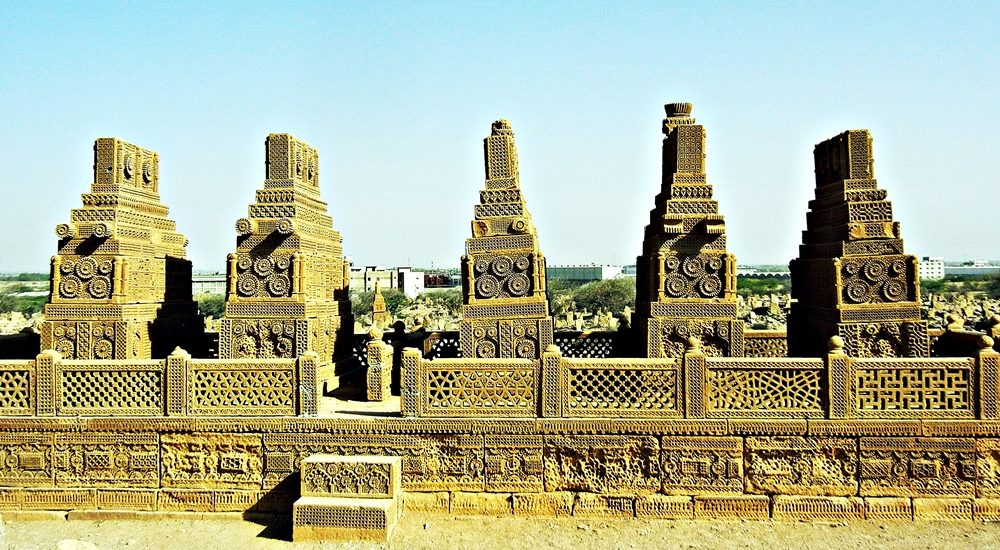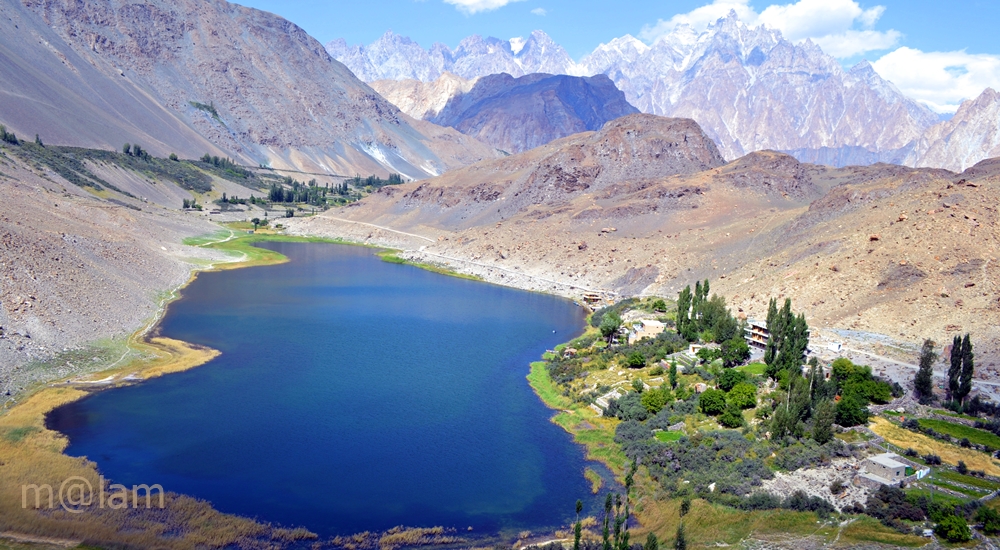Excursions from Skardu – Explore the Mesmerizing Beauty

Skardu, located in Gilgit-Baltistan, Pakistan, is a gateway to some of the world’s highest mountains and longest glaciers. As the capital of the Baltistan Division, one of the three divisions (Gilgit, Diamer, and Baltistan) of Gilgit-Baltistan, Skardu is one of the four key districts (Skardu, Shigar, Ghanche, and Kharmang) in the Baltistan Division. Each district is renowned for its unique manmade and natural attractions that draw tourists. Skardu serves as an excellent base for exploring the area’s key attractions. Recommended day excursions from Skardu include:
Day Excursion to Shigar Valley

Shigar Valley, situated in the Shigar District of Gilgit-Baltistan, is renowned for its stunning landscapes and tranquil ambiance. Surrounded by towering mountains, cascading waterfalls, and crystal-clear rivers, the valley is a paradise for nature enthusiasts. It offers a perfect escape from bustling city life, allowing visitors to immerse themselves in the wonders of the great outdoors. As a former princely state and one of the four districts of the Baltistan Division, Shigar is the nearest and most conveniently accessible destination. Located just 45 km away and reachable within an hour, Shigar boasts a range of exclusive tourist attractions, from historical sites to natural sceneries, including:
Sarfaranga Desert

The Cold Desert, located in Sarfaranga village in Skardu, Gilgit-Baltistan, is the world’s highest desert, standing at an altitude of nearly 7,500 feet. Known as the Sarfaranga Desert or Skardu Cold Desert, it is one of the two most famous icy deserts in the region. Situated close to Skardu, it is accessible with a 30-minute drive. Nestled in the Shigar Valley along the Indus River and surrounded by mountains, it serves as an excellent capstone experience for a trip to the Shigar area. The Sarfaranga Cold Desert is a hub of touristic activities, offering desert jeep safaris, motor gliding, biking, horse riding, and more.
Blind Lake

Blind LakeBlind Lake, also known as Xarba Tso in the local Balti language, is an enchanting freshwater lake nestled near the Shigar Valley in the heart of the Gilgit-Baltistan region of Pakistan. Unlike most lakes, Blind Lake does not rely on any external water supply or discharge source. Its serene waters remain still and unmoving, earning it the intriguing name “Blind Lake.” This mesmerizing lake offers panoramic views of its surroundings, particularly the riverside and the majestic mountains that serve as its backdrop. The trail leading to Blind Lake is a unique journey through lush greenery, arid deserts, and rugged rocky hills. Visitors can enjoy key activities like boating, camping, and musical events. There are a few tuck shops providing basic necessary items for tourists, and entry to the lakeside is subject to a fee.
Shigar Serena Fort Palace

The Shigar Fort in Skardu Valley is a remarkable architectural structure surrounded by Shigar’s vast plains. Renowned for its historical significance, Shigar Fort is the most visited location in Skardu. Constructed roughly 400 years ago, the entire structure is composed of stones with sturdy foundations. Formerly known as the Palace of Rock, the fort has been transformed into a guesthouse featuring 20 rooms and a large hall displaying treasures of the Baltit culture.
Amburiq Mosque

The Amburiq Mosque is one of the oldest mosques in Baltistan and is a renowned landmark in the region. Built by Sayed Ali Hamdani, it holds great historical significance. According to local traditions, Sayed Ali Hamdani visited Shigar to spread the faith and established the Amburiq Mosque, making it the first mosque in the Shigar Valley. A small museum inside the mosque raises awareness about its historical importance and encourages the local community to adopt a conservationist approach towards culturally significant structures. The mosque underwent restoration between 1998 and 2000. In 2005, UNESCO awarded the mosque the Asia-Pacific Heritage Award.
Khanqah-e-Mualla

With the dawn of Islam in the Baltistan region in 1352 through Amir Kabir Syed Ali Hamadani, the construction of small mosques became common. One of the most monumental pieces from that era is Khanqah-e-Mualla, a valuable gift to the Shigar Valley. The credit for its establishment goes to Shah Nasir Tusi, who came from Tus, Iran, with his three daughters through the Siachen Glacier in 1591. Shah Nasir laid the foundation of the Khanqah in 1602. According to local folklore, he disappeared near the mountains of the Braldu Valley on his way to K2. The construction, materials, and design of the Khanqah have remained unchanged for more than four hundred years. Although it has undergone repairs multiple times, the materials and construction methods have always stayed the same.
Hashupi Garden
Hashupi Bagh, also known as Hashupi Garden, is the Apple and Cherry Garden nestled in the picturesque Shigar Valley. This magnificent garden is located amidst the majestic Karakoram Mountains in Gilgit-Baltistan, Pakistan. Hashupi Bagh is a haven for nature lovers and adventure seekers alike. Apart from its apple orchards, the garden features stunning cherry blossoms that bloom during the spring season, transforming the landscape into a spectacle of delicate pink and white flowers. The cherry blossoms create a magical ambiance, drawing photographers, nature enthusiasts, and romantics. Visitors can wander through the garden, marveling at the ethereal beauty of the blossoms and capturing unforgettable moments. In autumn, Hashupi Bagh bursts with vibrant colors as the apples and cherries ripen, ready to be harvested.
Chuturon Hot Springs
Chotron Hot Springs is a natural hot spring located in the Shigar district of Gilgit-Baltistan, Pakistan. Situated at an elevation of around 2,400 meters (7,874 feet) above sea level, it is surrounded by beautiful mountains and forests. The water in the hot spring is naturally heated by geothermal activity and is believed to have medicinal properties due to its high mineral content. The mineral water of these springs contains elements like sodium, potassium, calcium, magnesium, chlorides, fluorides, sulfates, phosphates, and bicarbonates, which may be responsible for curing various diseases. However, the water from the thermal springs of Chotron is unsuitable for drinking due to its high fluoride content and the presence of small amounts of total coliforms, likely from environmental bacteria and non-protective measures during sampling. Despite this, it is found to be suitable for bathing and other body contact activities.
Day Excursion to Khaplu Valley

At an elevation of 2600 meters (8500 feet), Khaplu, formerly a princely state until 1974, serves as the administrative capital of Ghanche District in Gilgit-Baltistan. Located 102 kilometers east of Skardu, the city is accessible via a narrow metal road, requiring approximately 2.5 to 3 hours of travel time. Historically, Khaplu was the largest kingdom under the Yabgo Dynasty and guarded the trade route to Ladakh along the Shyok River, a tributary of the Indus. Today, Khaplu is a hub for mountaineering expeditions to renowned peaks such as Mashabrum, K6, K7, and Chogolisa. It is also a haven for trekkers, offering access to popular routes including Gondogoro La, Gondogoro Peak, Saraksa Glacier, Gondogoro Glacier, Masherbrum Glacier, Aling Glacier, Machlu Broq, Thaely La, Daholi Lake, Kharfaq Lake, Ghangche Lake, and Bara Lake. Explore this beautiful valley celebrated for its scenic beauty and cultural heritage. Major attractions in the Khaplu district include:
Chaqchan Mosque

The glorious Chaqchan Mosque was founded by Ameer Kabeer Syed Ali Hamadani (RA), dates back to 1370. This mosque is one of the oldest in the region, symbolizing the era when the local population converted en masse from Buddhism to Islam. The name “Chaqchan” means “The Miraculous Mosque.” It shares architectural similarities with mosques in the Kashmir Valley and Gilgit-Baltistan. The mosque consists of a two-story cubic complex: a semi-basement, a ground floor, and a turret atop. The architecture is a blend of Tibetan, Persian, and Mughal styles. The precise history of its construction is not well-documented. Located at a fair altitude near Serena Khaplu Fort, the mosque is a prime tourist attraction in Khaplu.
Khaplu Fort Palace

Locally known as Yabgo Khar, Khaplu Palace is an old fort and palace located in Khaplu. Built in the mid-19th century to replace an earlier fort nearby, the palace is considered an architectural heritage site and a significant tourist attraction. It served as the royal residence for the Raja of Khaplu. From 2005 to 2011, Khaplu Palace underwent a restoration project carried out by the Aga Khan Trust for Culture under the Aga Khan Historic Cities Programme. Today, the palace houses a hotel operated by Serena Hotels and a museum that depicts the history and culture of Baltistan.
Kharfaq Lake

Kharfaq Lake, also known as Riochug Tso in the local language, is located at an altitude of approximately 13,000 feet (4,300 meters) in the southeast of Kharfaq Village, about 22 km (a 20-minute drive) from Khaplu. This fascinating lake is surrounded by high mountains on all sides. To reach the lake, one must start the climb from Kharfaq village in a southeasterly direction. The trek involves a steep climb of 2-4 hours, requiring a good level of physical fitness. The lake is fed by glacial streams and seemingly has no outlet. Its crystal-clear, slightly brackish water is home to indigenous fish species, including trout and local fish.
Mosque Sofia Noorbakhsia Gharbochong
Masjid Garbochung, known locally as Thoqsikhar, which means “The Fort on the Roof,” is a historical site that was once home to Yabgo Khar or Khaplu Fort 300 years ago. Although only a mosque and remnants of the fort’s structure remain today, this location holds significant historical value. The palace that once stood here was built in the mid-19th century, replacing an earlier fort. Khaplu Palace is now recognized as an architectural heritage site and a popular tourist attraction.
Khanqah-e-Mualla Noorbakshia Khaplu Bala

Khanqah Khaplu is the largest Khanqah built from mud and wood in the region of Gilgit-Baltistan. It is considered the biggest mosque in Asia made purely of wood and mud. Located in Khaplu, it was constructed around 400 years ago by Mir Mukhtar Akhyar, a Sufi master of the Nurbakshi Order. The architecture of the mosque is a blend of Tibetan, Iranian, and Mughal styles. It is one of the oldest mosques in the Baltistan region, making it a famous landmark and a major tourist attraction.
Day Excursion to Kharmang
Located 120 km from Skardu, Kharmang District is a picturesque destination offering a variety of tourist attractions that showcase its natural beauty and cultural heritage. Known for its serene ambiance and traditional villages, the valley provides visitors with an authentic glimpse into the local Balti culture. Kharmang Valley is a popular spot for nature lovers and those seeking peaceful surroundings amidst stunning landscapes in the northern areas of Pakistan. Its lush green pastures, terraced fields, fruit orchards, fresh gushing springs, and snow-capped Karakoram Mountains create breathtaking scenery. Despite being the smallest district in the Baltistan Division, it is famous for its fascinating waterfalls.
Manthoka Waterfall

Manthokha Waterfall is located in Manthoka village in Kharmang district, Baltistan Division, in Gilgit-Baltistan, in the extreme northern region of Pakistan. The waterfall stands at approximately 180 feet high and is situated about 80 kilometers (50 miles) from Skardu. Set amidst green pastures, streams, and the towering rocky mountains of the Karakoram, the waterfall offers a stunning natural spectacle. A nearby restaurant serves local trout fish, and visitors can also explore the fish farm. Manthokha Waterfall is one of the most popular tourist spots around Skardu, attracting both local and international visitors. To reach Manthokha Waterfall from Skardu, one must follow the Kargil-Skardu route.
Khamosh Waterfall
Khamosh Waterfall, also known as Shirithing Waterfall Kharmang, is a majestic cascade located in Hamzigon village, Kharmang district of Baltistan. Surrounded by rugged terrain and dense forests, Khamosh Waterfall captivates visitors with its pristine beauty and soothing sounds. It is one of the highest waterfalls in the region. The water streams down from an overhung rock without forming a plunge pool at the base, creating a magical effect as the droplets scatter upon striking the solid rocks below. The waterfall is encircled by the Rocky Mountains, adding to its allure and making it a stunning natural wonder.
Mehdiabad Village
The picturesque views of Dapa, Kasho, and Mehdiabad not only soothe the eyes but also capture the hearts and minds of visitors. The area is rich in flora and fauna, offering a diverse natural environment. Trout fish is abundant throughout the valley, making it a paradise for fishing and angling enthusiasts.
Day Excursion to Deosai National Park

Deosai National Park is a high-altitude plateau connecting Astore District of Gilgit-Baltistan with Skardu District, and is a major tourist attraction in the region. Known as the “Land of Giants,” the park sits at an elevation of 13,600 feet above sea level, covering an expansive 3,626 square kilometers. It is renowned for its unique flora and fauna, featuring vast plains adorned with colorful wildflowers during the summer months. Deosai National Park is Pakistan’s second-largest alpine plateau and serves as a thriving habitat for diverse wildlife, including the elusive Himalayan brown bear. Nestled among four major mountain ranges—the Karakoram, Ladakh Range (Trans-Himalaya), Zanskar Range (Trans-Himalaya), and Himalayas—this stunning region offers unparalleled panoramic views of the surrounding mountains.
Ali Malik Mar Pass (Deosai Top)
Located approximately 30 km uphill from Skardu, Ali Malik Mar Pass offers an adventurous half-day excursion with panoramic views. It marks the end of the Deosai Plains when approached from the Astore side.
Bara Pani
Bara Pani, meaning “Large Body of Water” in Urdu, is the most popular place to stay in Deosai. It boasts the most facilities and offers the best views. Behind the campground, there is a hill with a 300-meter altitude gain that provides breathtaking views of the plains and Nanga Parbat, especially stunning at sunrise.
Kala Pani
Kala Pani, meaning “Black Water” in Urdu, is smaller and quieter compared to Bara Pani but is less scenic. It is located about 45 minutes away from Bara Pani.
Sheosar Lake

Sheosar Lake is an alpine lake situated in Deosai National Park, Gilgit-Baltistan, Pakistan, at an altitude of 4,142 meters (13,589 feet). It graces the plateau like a beauty mark, surrounded by snow-capped hills and lush green patches adorned with wildflowers. This lake holds the record for the highest elevation of its kind in the world. The deep blue waters contrast beautifully with the verdant plains of Deosai, while in the background, the formidable mountains of Nanga Parbat add to the mesmerizing scenery. Each season brings its own charm to the lake: in winter, it freezes over, and in summer, its myriad colors captivate visitors.
Day Excursion to Basho Valley
The Basho Valley, renowned for its stunning beauty, majestic snow-capped mountains, and pristine charm, is a favored destination in Skardu. Situated nearly 8,800 feet above sea level, the valley is approximately 45 km (about 2 hours’ drive) from Skardu. Surrounded by towering mountains on three sides, Basho Valley is rich in wildlife, including deer, markhor, ibex, and snow leopards. It stands out in the region for its expansive forests, lush greenery, serene atmosphere, breathtaking landscapes, making it the premier eco-adventure destination in Baltistan offering a peaceful retreat even during the hottest summers. It is an ideal spot for camping and trekking, boasting expansive green plains and flowing streams. At night, the valley becomes even more enchanting as the sky fills with thousands of stars overhead. Basho Valley is accessible via an adventurous drive from the main Skardu-Jaglot Road near Alam Bridge.
Day Hike to Marsur Rock

Situated in the heart of Hussainabad Village, en route from Shigar to Skardu, Marsur Rock (also known as Hussainabad Rock) stands as a remarkable geological wonder in this region, famous for its distinctive geological features. At an elevation of 3757 meters, Marsur Rock is a towering rock spire perched majestically on a mountain ridge. High above the Hussainabad Valley, it bears a striking resemblance to Norway’s famous Trolltunga. What sets it apart is that out of its 38-foot total length, a whopping 25 feet extends dramatically into thin air, offering daring adventurers the opportunity to savor a breathtaking bird-eye-view of the Skardu and surrounding Karakorum mountains and valley and capture daring photographs. The hike is strenuous for the beginners but still doable. It costs almost an entire day to hike up and return.
Skardu is an absolute paradise for travelers seeking an unforgettable experience amid nature’s finest creations. From the mystical plateaus to the serene lakes, the beauty within and around Skardu is simply inexpressible. However, it’s essential to plan your trip carefully, considering the remote location and high altitude.











